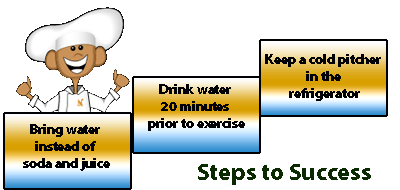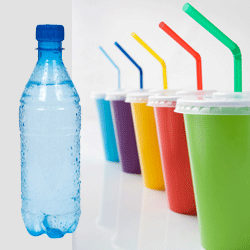
If someone gave you a cup full of sugar and asked you to drink it, would you? Or would you allow your child to add 56 grams or more of sugar to his or her beverage? Well, if your child or teen drinks a typical 20-ounce soda, then they might as well fill a cup with sugar and sip on it because it contains on average 56-77 grams of sugar!! Not only what food we eat matters and can affect our health, but also what we drink – every sip counts! Sipping on sugary-sweetened beverages can add unnecessary calories to your child’s diet with very little or no nutrients needed for healthy growth.
As found in many studies, sugar-sweetened beverages like soda, energy drinks, sport drinks, fruit punch, flavored water, flavored milk, and fruit juice are considered the largest contributor of added sugar in an American diet. On average, kids between the ages of 6-11 drink about 15 ounces of soda a day, and adolescents get 11% of their calories or 15 teaspoons of sugar from soft drinks*. There are many contributors to childhood obesity, however, the high consumption of sugar-sweetened drinks amongst kids is considered the largest contributor.
Now… The Truth!
It might be hard to say “no” to your child or teen when it comes to drinking sugar-sweetened beverages, especially with the constant non-stop advertisement geared towards them to drink these beverages. But before you feel guilty about saying “no”, let’s take a closer look at how many teaspoons of sugar are in these popular drinks:
|
Drink |
Size of Container |
Teaspoons of sugar per container |
|
Soda |
20 fl. oz. bottle |
17 tsp. |
|
Sports Drink |
20 fl. oz. bottle |
9 tsp. |
|
Energy Drink |
16 fl. oz. can |
15 tsp. |
|
Juice Drink |
20 fl. oz. bottle |
17 tsp. |
|
Sweetened Tea |
20 fl. oz. bottle |
14 tsp. |
|
Vitamin-added Water |
20 fl. oz. bottle |
8 tsp. |
|
Fruit-flavored Soda |
12.5 fl. oz. bottle |
11 tsp. |
Chart adapted from the California Department of Public Health’s Network for a Healthy California
The good news is that you can choose healthier beverage options for yourself and family, and greatly influence your kid’s preferences at an early age! You can avoid excess calories from sugary drinks by reading “Nutrition Facts” label located in the back of the beverage container. There are few things you need to look for when reading “Nutrition Facts” label:
Serving size: It’s important to pay attention to serving size because sometimes there are more than one serving in a beverage container.
Calories: Beverage containers may give the calories for only part of the contents, so don’t forget to do the math and multiply calories by the number of servings, for example, if one serving of fruit punch is 180 calories , but there is 2 ½ servings in the same container, then multiply 180 x 2 ½ = 450 calories
Sugar, sugar, SUGAR: You definitely want to look at how much sugar is in your drink to limit added sugar consumption. Divide the total grams of sugar by 4 to figure out how many teaspoons are inside your drink (4 grams of sugar = 1 teaspoon).
If the beverage container has more than one serving then multiply the number of teaspoons by the number of servings to get the total number of teaspoons of sugar.
Choosing water instead of sugar-sweetened beverages is a healthier option, it contains no calories, sugar, or fat. Water is a refreshing drink that your body needs. Adults and children need to drink water throughout the day to stay healthy and hydrated. So, offering your child 6-8 oz of water with meals and snacks can be a great way to ensure they stay hydrated. If your child is not a big fan of water, then it’s time to flavor their water by adding sliced lemons, lime, strawberries, orange, grapefruit, cucumber, apple, berries, melon, or pineapple.
Out of Sight, Out of Mind
Your kid will most likely drink a sugary beverage if they find it in the kitchen. It can be a lot easier to help them avoid drinking sugar-sweetened drinks that cause excessive weight gain and cavities, if they don’t exist at home. Instead purchase low fat milk, 100% fruit juice (4 oz = 1 fruit serving), and unsweetened beverages. You could also make fun smoothies with low fat milk and fruits!
Remember sugary drinks = extra calories = extra weight. So remind yourself to rethink your drink for a better and healthier you!

0 Comments